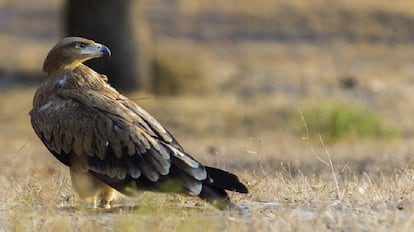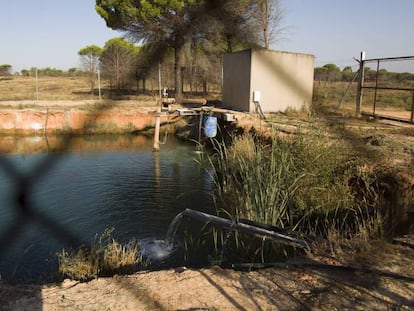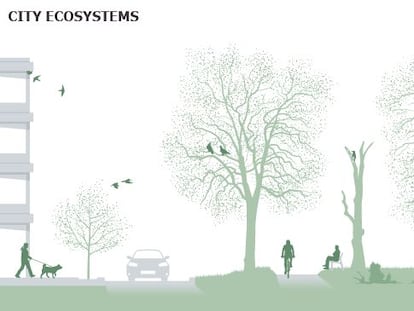Spain’s Iberian Imperial Eagle population soars to historic heights in Doñana
After years on the brink of extinction, this rare bird is reaching numbers not seen for 30 years in the Andalusian National Park

It's been 30 years since the Iberian Imperial Eagle flew over Doñana like this. Thanks to the birth of 15 chicks this season, one of Europe's most important wetlands has been pulled back from the brink of extinction and is enjoying a historic boom.
“It's been a milestone,” says Carlos Dávila, a biologist and technician with the Spanish NGO BirdLife. “We have recovered the numbers we had in the 1980s. It's a triumph.”
Six of the nine adult breeding pairs that live in Doñana, in Spain's southwestern province of Cadiz, have reproduced successfully, according to the NGO’s data. The average number of chicks per nest has been 2.5. “We have had four nests with three chicks each,” says Dávila. “It's higher than the average. These are exceptional results.”
The main reason for this conservation breakthrough is the food the technicians are strategically leaving for the eagles. “The Iberian Imperial Eagle is very dependent on this because there is practically no food for it in Doñana,” says Dávila.
Meanwhile, in Spain and Portugal, 500 breeding pairs of Iberian Imperial Eagle have been identified, which means that, though still vulnerable, it is no longer in immediate danger of extinction
Rabbits make up 70% of the eagle’s diet – a food source it must share with the Iberian Lynx. The fact that the number of rabbits in Doñana has dwindled to almost zero has had serious repercussions for its predators.
“The rabbit population has fallen by more than 90%,” says Dávila. “This means that the eagle has literally nothing to eat.”
A lack of food often leads to infighting among the chicks. It also prompts the adult birds to hunt outside of the protected area, exposing them to danger from electric wires and hunters.
The solution has been to identify the eagles’ hunting grounds and hang dead rabbits at the top of trees and on high branches so that other predators can't steal them.
“We know this is working because later we find the remains in their nests when we go to ring them,” says the biologist.
Other birds, such as the black kite (common to Doñana), or the vulture sometimes try for the food but so far it hasn’t affected the scheme. “The Imperial Eagle measures more than 2 m across so if it wants to get the rabbit, it will.”
The NGO stresses that its intervention is strictly supplementary and doesn’t stop the eagle from hunting. It is aimed at specific birds, particularly those about to reproduce or whose chicks have just been born.
“The male or female bird brings the rabbit back and feeds the chicks with it,” says Dávila. “It's a nutritional boost for them.”
There is, however, little point in supplementing the eagle’s food unless there is a parallel scheme to reverse the drop in the rabbit population, according to Dávila. “That is why the figures are such an achievement,” he says. “The last time the eagle thrived like this in Doñana was before the rabbit population was struck by the viral haemorrhagic disease.”
Doñana’s significance
Doñana’s isolation makes it a unique environment for the eagle. Before embarking on a program to boost the species in Cadiz, the eagles in Doñana were exclusively inbred.
“They didn’t mix with other populations so their genetic make-up is very similar,” says Dávila. “This means that if we lost them, we would be irreparably losing a unique sub-species of eagle.”
Sign up for our newsletter
EL PAÍS English Edition has launched a weekly newsletter. Sign up today to receive a selection of our best stories in your inbox every Saturday morning. For full details about how to subscribe, click here
On account of its singularity, experts are asking the Andalusian parliament to put long-term measures in place to ensure its conservation.
Meanwhile, in Spain and Portugal, 500 breeding pairs of Iberian Imperial Eagle have been identified, which means that, though still vulnerable, it is no longer in immediate danger of extinction. “It’s great news and means we can keep insisting thatm with the right financing and effort, we can protect species in danger of extinction,” says Dávila.
English version by Heather Galloway.
Tu suscripción se está usando en otro dispositivo
¿Quieres añadir otro usuario a tu suscripción?
Si continúas leyendo en este dispositivo, no se podrá leer en el otro.
FlechaTu suscripción se está usando en otro dispositivo y solo puedes acceder a EL PAÍS desde un dispositivo a la vez.
Si quieres compartir tu cuenta, cambia tu suscripción a la modalidad Premium, así podrás añadir otro usuario. Cada uno accederá con su propia cuenta de email, lo que os permitirá personalizar vuestra experiencia en EL PAÍS.
¿Tienes una suscripción de empresa? Accede aquí para contratar más cuentas.
En el caso de no saber quién está usando tu cuenta, te recomendamos cambiar tu contraseña aquí.
Si decides continuar compartiendo tu cuenta, este mensaje se mostrará en tu dispositivo y en el de la otra persona que está usando tu cuenta de forma indefinida, afectando a tu experiencia de lectura. Puedes consultar aquí los términos y condiciones de la suscripción digital.
More information
Últimas noticias
Reinhard Genzel, Nobel laureate in physics: ‘One-minute videos will never give you the truth’
Pinochet’s victims grapple with José Antonio Kast’s rise in Chile
How Japan is trying to avert ‘digital defeat’
The complicated life of Francesca Albanese: A rising figure in Italy but barred from every bank by Trump’s sanctions
Most viewed
- Pablo Escobar’s hippos: A serious environmental problem, 40 years on
- Why we lost the habit of sleeping in two segments and how that changed our sense of time
- Charles Dubouloz, mountaineering star, retires at 36 with a farewell tour inspired by Walter Bonatti
- Trump’s obsession with putting his name on everything is unprecedented in the United States
- The Florida Keys tourist paradise is besieged by immigration agents: ‘We’ve never seen anything like this’











































